Publish Date: Aug 10, 2021 | Keywords: Aviation, Comfort, Comfort Congress 2021, Publications, Seating
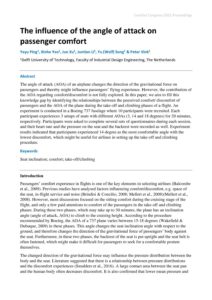 |
Author
Yayu Ping, Xinhe Yao, Jun Xu, Juntian Li, Yu (Wolf) Song & Peter Vink |
Abstract
The angle of attack (AOA) of an airplane changes the direction of the gravitational force on passengers and thereby might influence passengers’ flying experience. However, the contribution of the AOA regarding comfort/discomfort is not fully explored. In this paper, we aim to fill this knowledge gap by identifying the relationships between the perceived comfort/ discomfort of passengers and the AOA of the plane during the take-off and climbing phases of a flight. An experiment is conducted in a Boeing 737 fuselage where 10 participants were recruited. Each participant experiences 3 setups of seats with different AOAs (3, 14 and 18 degrees) for 20 minutes, respectively. Participants were asked to complete several sets of questionnaires during each session, and their heart rate and the pressure on the seat and the backrest were recorded as well. Experiment results indicated that participants experienced 14-degree as the most comfortable angle with the lowest discomfort, which might be useful for airlines in setting up the take-off and climbing procedure. |
Publish Date: Aug 9, 2021 | Keywords: Autonomous vehicles, Comfort, Comfort Congress 2021, Publications, Seating
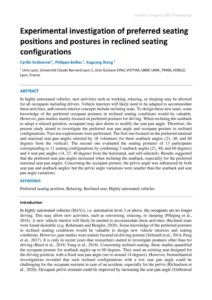 |
Author
Cyrille Grébonval, Philippe Beillas, Xuguang Wang |
Abstract
In highly automated vehicles, new activities such as working, relaxing, or sleeping may be allowed for all occupants including drivers. Vehicle interiors will likely need to be adapted to accommodate these activities, and current interior concepts include reclining seats. To design these new seats, some knowledge of the preferred occupant postures in reclined seating conditions would be valuable. However, past studies mainly focused on preferred postures for driving. When reclining the seatback to adopt a relaxed position, occupants may also desire to modify the seat pan angle. Therefore, the present study aimed to investigate the preferred seat pan angle and occupant posture in reclined configurations. Two test experiments were performed. The first one focused on the preferred minimal and maximal seat pan angles selected by 18 volunteers for three seatback angles (21, 40, and 60 degrees from the vertical). The second one evaluated the seating postures of 13 participants corresponding to 11 seating configurations by combining 3 seatback angles (21, 40, and 60 degrees) and 4 seat pan angles (14, 27, 40 degrees from the horizontal, and self-selected). Results suggested that the preferred seat pan angles increased when reclining the seatback, especially for the preferred maximal seat pan angles. Concerning the occupant posture, the pelvis angle was influenced by both seat pan and seatback angles; but the pelvic angle variations were smaller than the seatback and seat pan angle variations. |
Publish Date: Aug 10, 2021 | Keywords: Comfort, Comfort Congress 2021, Publications, Seating
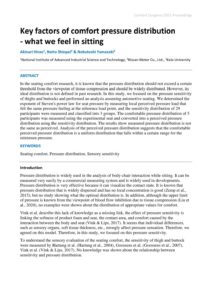 |
Author
Akinari Hirao, Naito Shinpei & Nobutoshi Yamazaki |
Abstract
In the seating comfort research, it is known that the pressure distribution should not exceed a certain threshold from the viewpoint of tissue compression and should be widely distributed. However, its ideal distribution is not defined in past research. In this study, we focused on the pressure sensitivity of thighs and buttocks and performed an analysis assuming automotive seating. We determined the exponent of Steven's power law for seat pressure by measuring local perceived pressure load that felt the same pressure feeling at the reference load point, and the sensitivity distribution of 29 participants were measured and classified into 3 groups. The comfortable pressure distribution of 5 participants was measured using the experimental seat and converted into a perceived pressure distribution using the sensitivity distribution. The results show measured pressure distribution is not the same as perceived. Analysis of the perceived pressure distribution suggests that the comfortable perceived pressure distribution is a uniform distribution that falls within a certain range for the minimum pressure. |
Publish Date: Aug 9, 2021 | Keywords: Aviation, Comfort, Comfort Congress 2021, Publications, Seating
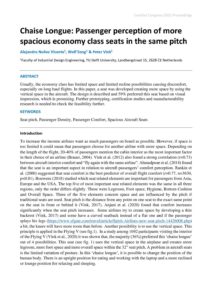 |
Author
Alejandro Nuñez Vicente, Wolf Song & Peter Vink |
Abstract
Usually, the economy class has limited space and limited recline possibilities causing discomfort, especially on long haul flights. In this paper, a seat was developed creating more space by using the vertical space in the aircraft. The design is described and 59% preferred this seat based on visual impression, which is promising. Further prototyping, certification studies and manufacturability research is needed to check the feasibility further. |
Publish Date: Aug 11, 2021 | Keywords: Automotive, Autonomous vehicles, Comfort, Comfort Congress 2021, Publications, Seating, User experience
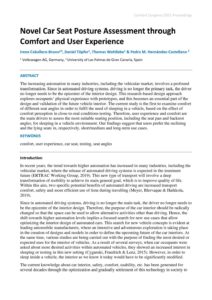 |
Author
Irene Caballero-Bruno, Daniel Töpfer, Thomas Wohllebe & Pedro M. Hernández-Castellano |
Abstract
The increasing automation in many industries, including the vehicular market, involves a profound transformation. Since in automated driving systems, driving is no longer the primary task, the driver no longer needs to be the epicenter of the interior design. This research-based design approach explores occupants’ physical experience with prototypes, and this becomes an essential part of the design and validation of the future vehicle interior. The current study is the first to examine comfort of different seat angles in order to fulfil the need of sleeping in a vehicle, based on the effect of comfort perception in close-to-real conditions testing. Therefore, user experience and comfort are the main drivers to assess the most suitable seating position, including the seat pan and backrest angles, for sleeping in a vehicle environment. Our findings suggest that users prefer the reclining and the lying seats in, respectively, short/medium and long-term use cases. |
Publish Date: Feb 27, 2019 | Keywords: Automotive, Contemporary EHF 2016, Fatigue & sleep, Musculoskeletal, Publications, Seating
| Document
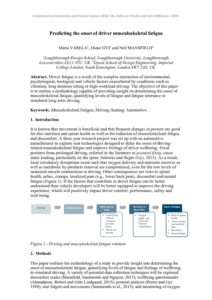
|
Author
Maria VARELA, Diane GYI and Neil MANSFIELD |
Abstract
Driver fatigue is a result of the complex interaction of environmental, psychological, biological and vehicle factors exacerbated by conditions such as vibration, long duration sitting or high-workload driving. The objective of this paper is to outline a methodology capable of providing insight on determining the onset of musculoskeletal fatigue, quantifying levels of fatigue and fatigue tolerance in simulated long-term driving. |
Publish Date: Aug 19, 2021 | Keywords: Aviation, Comfort Congress 2021, Publications, Seating
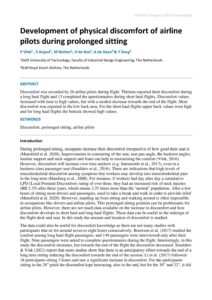 |
Author
P Vink, S Anjani, M Netten, H de Ree, A de Haan & Y Song |
Abstract
Discomfort was recorded by 26 airline pilots during flight. Thirteen reported their discomfort during a long haul flight and 13 completed the questionnaires during short haul flights. Discomfort values increased with time to high values, but with a modest decrease towards the end of the flight. Most discomfort was reported in the low back area. For the short haul flights upper back values were high and for long haul flights the buttock showed high values. |
Publish Date: Jun 12, 2023 | Keywords: Anthropometry, Comfort, Contemporary EHF 2023, Education, training & skills, Publications, Safety, Seating
| Document
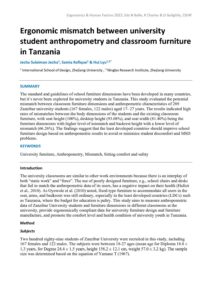
|
Author
Jecha Suleiman Jecha, Samia Rafique & Hui Lyu |
Abstract
The standard and guidelines of school furniture dimensions have been developed in many countries, but it’s never been explored for university students in Tanzania. This study evaluated the potential mismatch between classroom furniture dimensions and anthropometric characteristics of 289 Zanzibar university students (167 females, 122 males) aged 17- 27 years. The results indicated high rates of mismatches between the body dimensions of the students and the existing classroom furniture, with seat height (100%), desktop height (93.08%), and seat width (81.40%) being the furniture dimensions with higher level of mismatch and backrest height with a lower level of mismatch (66.26%). The findings suggest that the least developed countries should improve school furniture design based on anthropometric results to avoid or minimize student discomfort and MSD problems. |
Publish Date: Aug 18, 2021 | Keywords: Aviation, Comfort, Comfort Congress 2021, Musculoskeletal, Publications, Seating
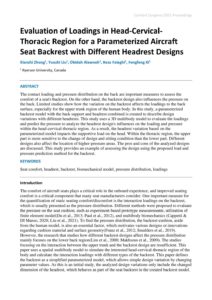 |
Author
Xianzhi Zhong, Yuezhi Liu, Obidah Alawneh, Reza Faieghi & Fengfeng Xi |
Abstract
The contact loading and pressure distribution on the back are important measures to assess the comfort of a seat's backrest. On the other hand, the backrest design also influences the pressure on the back. Limited studies show how the variation on the backrest affects the loadings to the back surface, especially for the upper trunk region of the human body. In this study, a parameterized backrest model with the back support and headrest combined is created to describe design variations with different headrests. This study uses a 3D multibody model to evaluate the loadings and predict the pressure to analyze the headrest design's influences on the loading and pressure within the head-cervical-thoracic region. As a result, the headrest variation based on the parameterized model impacts the supportive load on the head. Within the thoracic region, the upper part is more sensitive to the change of design and sitting condition than the lower part. Different designs also affect the location of higher-pressure areas. The pros and cons of the analyzed designs are discussed. This study provides an example of assessing the design using the proposed load and pressure prediction method for the backrest. |
Publish Date: Aug 12, 2021 | Keywords: Automotive, Comfort, Comfort Congress 2021, Design, Perception, Publications, Seating, Usability
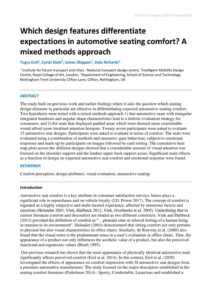 |
Author
Tugra Erol, Cyriel Diels, James Shippen & Dale Richards |
Abstract
The study built on previous work and earlier findings where it asks the question which seating design elements in particular are effective in differentiating expected automotive seating comfort. Two hypothesis were tested with a mixed methods approach 1) that automotive seats with triangular integrated headrests and angular shape characteristics lead to a holistic evaluation strategy for consumers, and 2) for seats that displayed padded areas which were deemed more comfortable would afford more localised attention hotspots. Twenty seven participants were asked to evaluate 15 automotive seat designs. Participants were asked to evaluate in terms of comfort. The seats were evaluated using a combination of methods and measures: gaze behaviour, subjective emotional responses and mark-up by participants on images followed by card sorting. The cumulative heat map plots across the different designs showed that a considerable amount of visual attention was focused on the shoulder support and the lumbar upper back support areas. Significant main effects as a function of design on expected automotive seat comfort and emotional response were found. |
Publish Date: Aug 10, 2021 | Keywords: Aviation, Comfort, Comfort Congress 2021, Publications, Seating
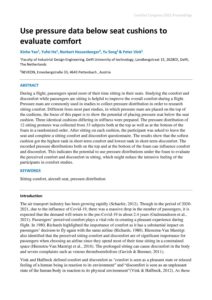 |
Author
Xinhe Yao, Yufei He, Norbert Hessenberger, Yu Song & Peter Vink |
Abstract
During a flight, passengers spend most of their time sitting in their seats. Studying the comfort and discomfort while passengers are sitting is helpful to improve the overall comfort during a flight. Pressure mats are commonly used in studies to collect pressure distribution in order to research sitting comfort. Different from most past studies, in which pressure mats are placed on the top of the cushions, the focus of this paper is to show the potential of placing pressure mat below the seat cushion. Three identical cushions differing in stiffness were prepared. The pressure distribution of 12 sitting postures was collected from 33 subjects both at the top as well as at the bottom of the foam in a randomized order. After sitting on each cushion, the participant was asked to leave the seat and complete a sitting comfort and discomfort questionnaire. The results show that the softest cushion got the highest rank in short-term comfort and lowest rank in short-term discomfort. The recorded pressure distributions both on the top and at the bottom of the foam can influence comfort and discomfort. This indicates the potential to use pressure distributions under the foam to evaluate the perceived comfort and discomfort in sitting, which might reduce the intrusive feeling of the participants in comfort studies. |
Publish Date: Aug 19, 2021 | Keywords: Aviation, Comfort, Comfort Congress 2021, Design, Publications, Seating
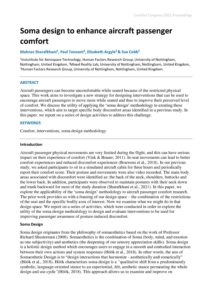 |
Author
Mahnaz Sharafkhani, Paul Tennen2, Elizabeth Argyle & Sue Cobb |
Abstract
Aircraft passengers can become uncomfortable while seated because of the restricted physical space. This work aims to investigate a new strategy for designing interventions that can be used to encourage aircraft passengers to move more while seated and thus to improve their perceived level of comfort. We discuss the utility of applying the ‘soma design’ methodology to creating these interventions, which aim to target specific body discomfort areas identified in a previous study. In this paper, we report on a series of design activities to address this challenge. |
Publish Date: Aug 11, 2021 | Keywords: Automotive, Autonomous vehicles, Comfort, Comfort Congress 2021, Publications, Seating
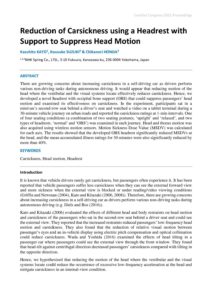 |
Author
Kazuhito Kato, Kousuke Suzuki & Chikanori Honda |
Abstract
There are growing concerns about increasing carsickness in a self-driving car as drivers perform various non-driving tasks during autonomous driving. It would appear that reducing motion of the head where the vestibular and the visual systems locate effectively reduces carsickness. Hence, we developed a novel headrest with occipital bone support (OBS) that could suppress passengers’ head motion and examined its effectiveness on carsickness. In the experiment, participants sat in a minivan’s second-row seat behind a driver’s seat and watched a video on a tablet terminal during a 30-minute vehicle journey on urban roads and reported the carsickness ratings at 1-min intervals. One of four seating conditions (a combination of two seating postures, ‘upright’ and ‘relaxed’, and two types of headrests, ‘normal’ and ‘OBS’) was examined in each journey. Head and thorax motion was also acquired using wireless motion sensors. Motion Sickness Dose Value (MSDV) was calculated for each axis. The results showed that the developed OBS headrest significantly reduced MSDVs at the head, and the mean accumulated illness ratings for 30 minutes were also significantly reduced by more than 40%. |
Publish Date: Aug 10, 2021 | Keywords: Aviation, Comfort Congress 2021, Publications, Seating
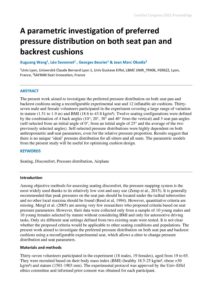 |
Author
Xuguang Wang, Léo Savonnet , Georges Beurier & Jean Marc Obadia |
Abstract
The present work aimed to investigate the preferred pressure distribution on both seat pan and backrest cushions using a reconfigurable experimental seat and 12 inflatable air cushions. Thirty-seven male and female volunteers participated in the experiment covering a large range of variation in stature (1.51 to 1.9 m) and BMI (18.6 to 43.8 kg/m²). Twelve seating configurations were defined by the combination of 4 back angles (10°; 20°, 30° and 40° from the vertical) and 3 seat pan angles (self-selected from an initial angle of 0°, from an initial angle of 25° and the average of the two previously selected angles). Self-selected pressure distributions were highly dependent on both anthropometric and seat parameters, even for the relative pressure proportion. Results suggest that there is no unique ‘ideal’ pressure distribution for all sitters and all seats. The parametric models from the present study will be useful for optimising cushion design. |
Publish Date: Aug 12, 2021 | Keywords: Comfort, Comfort Congress 2021, Design, Publications, Rail, Seating
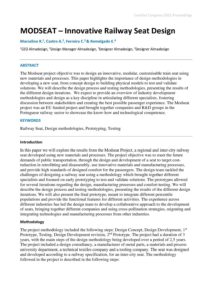 |
Author
Marcelino R., Castro A., Ferreira C. & Remelgado E. |
Abstract
The Modseat project objective was to design an innovative, modular, customisable train seat using new materials and processes. This paper highlights the importance of design methodologies in developing a new seat, from concept design to building physical models to test and validate solutions. We will describe the design process and testing methodologies, presenting the results of the different design iterations. We expect to provide an overview of industry development methodologies and design as a key discipline in articulating different specialists, fostering discussion between stakeholders and creating the best possible passenger experience. The Modseat project was an EU funded project and brought together companies and R&D groups in the Portuguese railway sector to showcase the know-how and technological competence. |
Publish Date: Aug 10, 2021 | Keywords: Anthropometry, Automotive, Autonomous vehicles, Comfort, Comfort Congress 2021, Publications, Seating
 |
Author
Mojtaba Mirakhorlo, Nick Kluft, Tugrul Irmak, Barys Shyrokau & Riender Happee |
Abstract
In future automated vehicles we will often engage in non-driving tasks and will not watch the road. This will affect postural stabilization and may elicit discomfort or even motion sickness in dynamic driving. Future vehicles shall accommodate this by properly designed seats and interiors whereas comfortable vehicle motion shall be achieved with smooth driving styles and well designed (active) suspensions. To support research and development in dynamic comfort, this paper presents validation of a multi-segment full body human model including visuo-vestibular and muscle spindle feedback for postural stabilization. Vibration transmission is evaluated using new tests with compliant automotive seats, applying 3D platform motion and evaluating 3D translation and rotation of pelvis, trunk and head. Dynamic driving is evaluated using a recently published “sickening drive” including a 0.2 Hz 4 m/s2 slalom. The model matches corridors of 3D human motion and reproduces vertical and fore-aft oscillations. Visuo-vestibular and muscle spindle feedback are shown to be essential in particular for head-neck stabilization. Active leg muscle control at the hips and knees is shown to be essential to stabilize the trunk in the high amplitude slalom condition but not in low amplitude horizontal vibrations. However, active leg muscle control can strongly affect 4-6 Hz vertical vibration transmission. Compared to the vibration tests, the dynamic driving tests show enlarged postural control gains to minimise head roll and pitch, and to align head yaw with the driving direction. Human modelling can create the required insights to achieve breakthrough comfort enhancements while enabling efficient development for a wide range of driving conditions, body sizes and other factors. Hence, modelling human postural control can accelerate innovation of seats and vehicle motion control strategies for (automated) vehicles. |
















